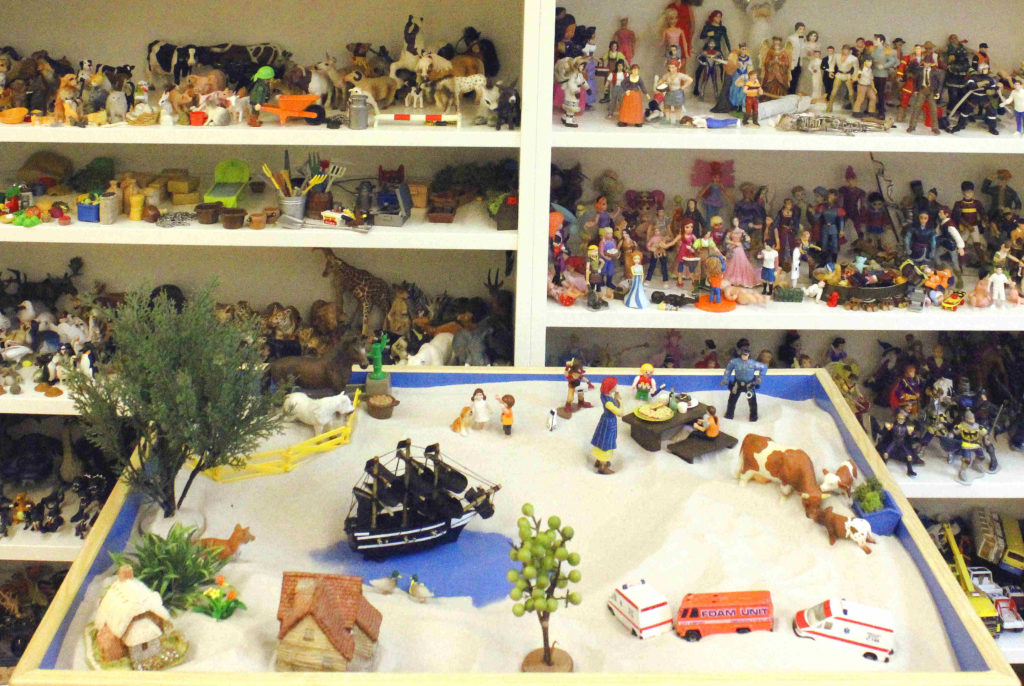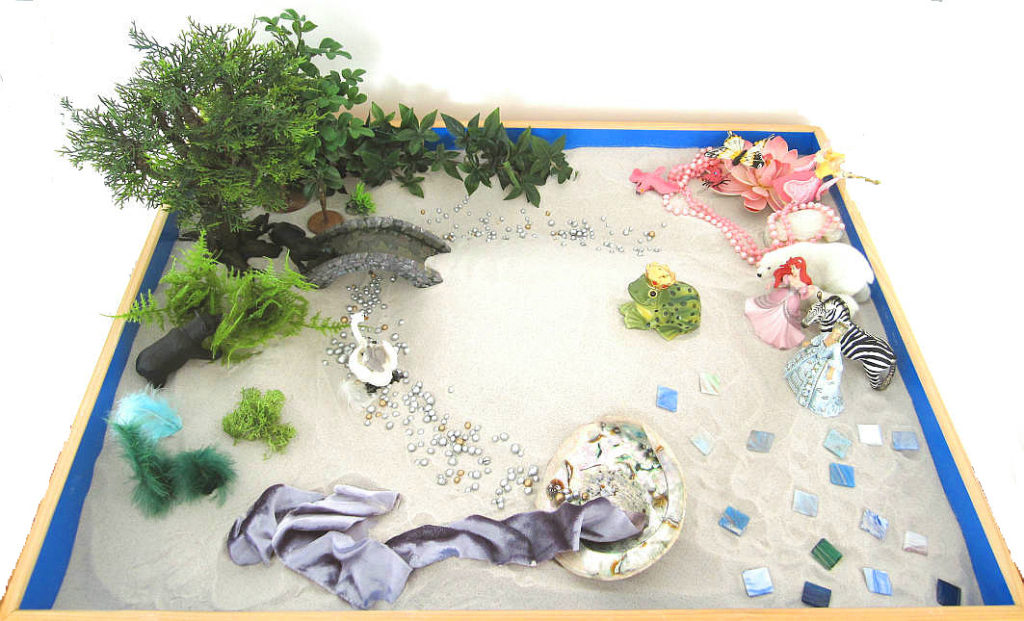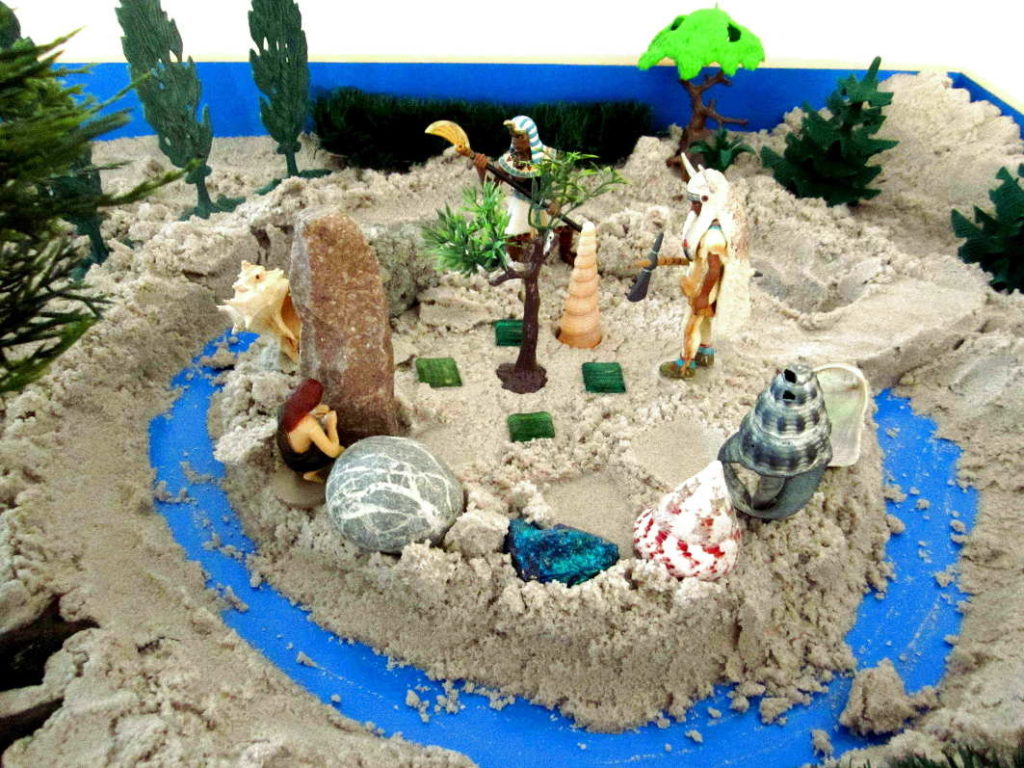Sandplay Therapy for Children and Adolescents

Sandtray with miniatures
Play is the innate way for children and adolescents to learn to cope with and understand the world
around them. Playfulness is necessary for all to reach maturity and to enfold ones innate resources
and talents. Playfulness and fantasy allows us to look at situations and problems from new angles,
to juggle with them and then find a creative and surprising solution to the situation. The ability to
play is necessary and essential also for learning, according to new studies in neuroscience.
Sandplay therapy can often help when a child does not play, when it can not concentrate or learn. It
is helpful for children who are emotionally unstable and fighting with siblings and schoolmates or
perhaps is bullying or bullied. Children who have suffered from trauma, illness or loss might not
want or dare to talk about it. It is easier to create descriptions of it in the sand.
Play allows children to solve their problems with a tool that they like and know how to use. This is
why sandplay is a most suitable form of therapy for children and it is also one of the fastest. The
method is based on the work made by Dora Kalff who was one of C.G. Jung’s students. Today this
form of therapy is used all over the world. Originally it was developed for children, today it is used
in the therapy for all ages and for many different problems.

Sandimage created by a young woman
The material for sandplay consists of two sand trays, one with fine dry sand the other with wet sand
and a set of miniatures of different kinds: humans, animals, houses, vehicles, natural material and
much more. The sand as such is important as material. Small children and also older children love
to pour the sand from one container to the other. It is calming to touch the cool sand and to feel it
flow over the skin.
Sandplay is non directive, this means that the child will work on the issues that are most important
in the moment. Art and play therapy are natural parts of the therapy, it is possible to draw, paint,
sculpt or work with other creative arts in the same hour if the child needs or wants to do that. It can
be completely absorbed by creating images in the sand in one session, the next time it is the grocery
store that needs to be displayed on the table, or the creation of objects using clay.
The work in the sand helps to develop dexterity and trust in ones own abilities. The sand as material
is very nice. It is easy to create satisfying shapes in the sand, it is not necessary to be artistic. With
the help of the sand and the miniatures it is easy to create beautiful images in the sandtray. The
children are proud of their creations. Also children who feel clumsy or find they can not draw, soon
find that they are really good at creating beautiful “sandscapes”. The sand images and other
creations are carefully documented and are in the end of the process given back to the child in form
of a “book”.

Detail of an image created by a 11 years old boy.
Sandplay works therapeutically in that it offers a safe space for the child, where difficult, scary or
not understood experiences and feelings can be worked on. There the child can rehearse difficult
situations, new approaches and solutions to problems can be tried out in the sand with the help of
miniatures, this on exactly the level where the child feels it can control the situation.
In this therapy it is not necessary to talk. The child does not have to explain in words why
something is scary or why one has “bad” feelings or gets upset. Therefore it is suitable also for
children who for some reasons do not want or who are not able to talk. Sandplay therapy allows
also a silent child a way to express itself.
Through the work in the sand a child can express feelings and memories for which there are no
words. There are experiences that children can not explain and feelings for which a child has no
words. Often the essence of the experiences can be expressed in an image or in a series of images in
the sand tray. In this way sandplay facilitates the healing process.
The process takes place on an unconscious level for the child. There is often a story expressed in the
tray and in the drawings and the child sometimes talks about what is happening while the story
evolves. With the help of the images in the sand the therapist can understand processes that are still
not in the scope of consciousness, or are not anymore remembered for various reasons.
The number of sessions needed varies. As long as the child finds it wants to come to the session
there is still work to be done. At some point it will experience that it is more important to play in the
yard or play with the best friend. This is the sign for that the need for therapy is not there anymore.
For adults sandplay can be used in combination with verbal therapy.
Margareta Ehnberg-Vital
Further reading:
Bradway, Katherine. 1990. Developmental stages in children’s sand worlds. In: Sandplay Studies – Origins, Theory and Practice. Bradway K.,
Signell, K.A., Spare, G.H., et.al.. 1990 Boston: Sigo Press.
Boik, Barbara and E. Anna Goodwin. 2000. Sandplay therapy. New York, London: W. W. Norton & Company.
Gonthard von, Alexander. 2007. Theorie und Praxis der Sandspielstherapie. Stuttgart: W. Kohlhammer.
Pattis Zoja, Eva. 2010. Sandplay. In: Jungian psychoanalysis, ed. Stein, Murray. Chicago and LaSalle, Illinois: Open Court.